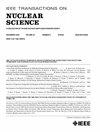Effect of Gamma Radiation on TaOₓ ECRAM
IF 1.9
3区 工程技术
Q3 ENGINEERING, ELECTRICAL & ELECTRONIC
引用次数: 0
Abstract
Electrochemical random access memory (ECRAM) is an emerging three-terminal nonvolatile memory (NVM) with highly controllable channel conductance which is promising for use as an analog memory (or synapse) in analog in-memory computing (IMC) systems. Energy-efficient analog IMC computing is particularly desirable for power-constrained, high-radiation environments such as satellites. However, little is known about the suitability of ECRAM for use in a total ionizing dose (TID) environment. This work investigates the effect of Co-60 gamma radiation on the channel conductance and noise—two properties critical for analog IMC systems—of a TaOx-based ECRAM up to 17.3 Mrad(SiO2) for both low- and high-channel-conductance state devices. A transient increase in conductance is observed in response to radiation which consists of two elements: an immediate increase in conductivity due to photocurrent and a secondary increase in conductivity, which has a slower rise and saturation and can persist for hours after exposure. This secondary, persistent photoconductivity is attributed to charging caused by hole trapping. These transient effects would not likely occur in a space environment due to the low dose rate compared with this experiment. No permanent change is found in the low conductance state (LCS) following exposure and the minor shift in the high conductance change would be less significant than the regular retention decay in this state. A permanent increase in the random telegraph noise is observed, possibly due to increased traps created in the channel. This work demonstrates that TaOx-based ECRAM is suitable for use in spaceborne analog IMC systems that are subject to significant TID.γ辐射对TaO的影响ₓECRAM
电化学随机存取存储器(ECRAM)是一种新兴的三端非易失性存储器(NVM),具有高度可控的通道电导,有望在模拟内存计算(IMC)系统中用作模拟存储器(或突触)。节能模拟IMC计算特别适合于功率受限的高辐射环境,如卫星。然而,ECRAM在总电离剂量(TID)环境中的适用性尚不清楚。这项工作研究了Co-60伽马辐射对通道电导和噪声的影响,这是模拟IMC系统的两个关键特性,taox基ECRAM高达17.3 Mrad(SiO2),适用于低通道和高通道电导状态器件。观察到电导率的瞬态增加是对辐射的响应,它由两个元素组成:由于光电流导致的电导率的立即增加和电导率的二次增加,其上升和饱和速度较慢,并可在暴露后持续数小时。这种二次的、持久的光电导率归因于空穴捕获引起的充电。由于与本实验相比剂量率较低,在空间环境中不太可能发生这些短暂效应。暴露后,在低电导状态(LCS)中没有发现永久性的变化,并且高电导变化中的微小变化将不如该状态下的常规保留衰减显著。观察到随机电报噪声的永久增加,可能是由于信道中产生的陷阱增加。这项工作表明,基于taox的ECRAM适用于受显著TID影响的星载模拟IMC系统。
本文章由计算机程序翻译,如有差异,请以英文原文为准。
求助全文
约1分钟内获得全文
求助全文
来源期刊

IEEE Transactions on Nuclear Science
工程技术-工程:电子与电气
CiteScore
3.70
自引率
27.80%
发文量
314
审稿时长
6.2 months
期刊介绍:
The IEEE Transactions on Nuclear Science is a publication of the IEEE Nuclear and Plasma Sciences Society. It is viewed as the primary source of technical information in many of the areas it covers. As judged by JCR impact factor, TNS consistently ranks in the top five journals in the category of Nuclear Science & Technology. It has one of the higher immediacy indices, indicating that the information it publishes is viewed as timely, and has a relatively long citation half-life, indicating that the published information also is viewed as valuable for a number of years.
The IEEE Transactions on Nuclear Science is published bimonthly. Its scope includes all aspects of the theory and application of nuclear science and engineering. It focuses on instrumentation for the detection and measurement of ionizing radiation; particle accelerators and their controls; nuclear medicine and its application; effects of radiation on materials, components, and systems; reactor instrumentation and controls; and measurement of radiation in space.
 求助内容:
求助内容: 应助结果提醒方式:
应助结果提醒方式:


